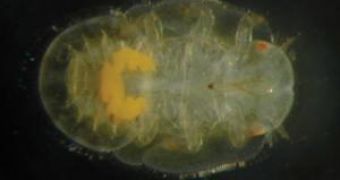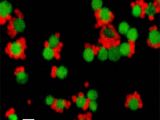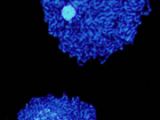The human body functions based on the activity of about 35,000 genes, comprised in 3 billion DNA bases. And even the bacteria needs hundreds of genes to cope with their metabolic functions. But there must be an extreme of functioning genes into an organism at which life is possible.
German researchers discovered in 2002, in northern Iceland, a very odd microbe inhabiting the volcanic bed of the sea. These bacteria reproduce only in very hot, oxygen free and sulfur rich waters of hydrothermal vents (associated with submarine volcanoes). Its name, Nanoarchaeum equitans ("primitive dwarf rider") refers to the fact that these types of ancient bacteria live on a much larger archebacterium (an ancient type of bacteria) called Ignicoccuis ("fire ball"), on which it depends for its growth in an obligatory symbiosis.
The microbes are so small (400 nanometers), that 6 millions would fit in a needle top. Only nanobacteria and nanobes are smaller, but many doubt their living status.
Nanoarchaeum possesses the smallest genome in the world: just 490,885 pairs of nucleotid bases. Just imagine that 3 pairs encode for an aminoacid, that a protein means from about 50-100 aminoacids to hundreds, and that each gene has a large DNA stretch which controls its activity like a starter... And many portions of the DNA do not encode genes... So that you can imagine in how very few genes this organism survives!
It lacks the genes for several vital metabolic pathways, and Nanoarchaeum cannot synthesize most nucleotides, amino acids, lipids, and cofactors. This can be compatible with life because Nanoarchaeum gets them from Ignicoccus. The organism also may not be able to produce its own ATP (the energy transporting molecule). Surprisingly, in 2006 even a smaller genome was found in a tiny symbiotic bacteria living inside special cells of a small aphid-related insect, named Carsonella ruddii.
It is only one-third the size of Nanoarchaeum's genome: just 159,662 base-pairs of DNA, which encode only 182 protein-coding genes.
Aphids eat plant saps, which are rich in sugar, but lack proteins, that's why the insects rely on Carsonella to get a balanced diet. The bacteria manufacture amino acids, and share the goodies with their hosts. Carsonella live inside the insect's cells and cannot survive on their own.
Endosymbiotic bacteria live in an extremely stable world, so they need a simple set of instructions and lost many of the metabolic pathways that free-living bacteria need to survive after so many generations of living within insects.
Carsonella lives inside a psyllid insect, called Pachypsylla venusta. It is possible that in the bacteria's evolutionary past, some of its genes were inserted into the insect's genome, allowing the insect to produce some of the metabolites required by the bacteria. This way, the bacteria lost those genes.
Animal and plant cells have specialized structures inside them, called organelles, with specific functions, and some are derived from endosymbiotic bacteria incorporated into the cell, over the course of evolution. The organelles responsible for energy production, called mitochondria, are thought to have once been free-roaming bacteria that larger cells assimilated long ago, and they still have their own DNA. Perhaps, one day Carsonella's small genome will lose its identity altogether and the microbe will turn into an organelle.

 14 DAY TRIAL //
14 DAY TRIAL // 

